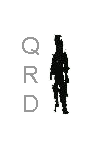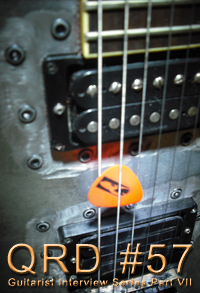
 |
| about
this issue
Guitarist Interviews with: Francesco Candura Justin O’Connor C Joynes Brandon W Pittman Killick Hinds Kyle Arthur Miller Mark Wol Dan West Olaf Rupp Lorne Hind Mark Nelsen Jordan Ferreira Willy B Andrè Erbyeah Shane Handal Interview Series Updates: Andras Fekete Martin Newman |
 |
 |
 |
 |
 |
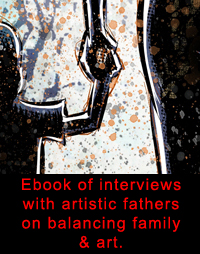 |
|
|
January 2013
Name: Martin Newman
Bands: Plumerai; Goddakk
Websites: www.plumerai.com, www.facebook.com/PlumeraiBand, www.myspace.com/goddakk, www.silbermedia.com/plumerai, www.silbermedia.com/goddakk
For the longest time I was a firm believer in Roland’s JC-120. Most of the guitar sounds I loved growing up roared & chimed through it & then later the Fender Twin Reverb caught my attention. Always a 2X12 combo of sorts. After hauling that around the eastern seaboard, up & down stairs or over gravel lots to & fro the back of the van I finally broke down & decided that I needed to go smaller without sacrificing sound. Realistically, I never needed half the power of the JC-120 playing in small to midsize clubs & often would be harassed by our vocalist to keep the volume down. So, I put together a travel friendly setup.
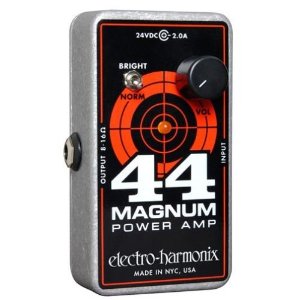 |
It all started with Electro Harmonix Magnum 44 power amp pedal. This little amp that fits onto my Pedal Train 2 board, gets as loud as I require & much like the JC-120, I’ve rarely ever had to crank it past the 15% mark. As the name indicates, it’s 44 watts & pushes out to either 8 or 16 ohm speakers, they make a cheaper 22 watt pedal called the 22 Caliber as well. From my experience, it has a good solid tone with no frills except a switch for bright or normal. |
| The Magnum powers a Fender Superchamp 1X12 cab. This cab maintains a good solid tone from the Magnum 44 & keeps in line with big sounds out of a small & light package. On my recent shot out to the west coast, I shoved this cab into a large suitcase & packed my clothes around it & not only was it easy to wheel around, it still kept me within the bounds of allowable weight for luggage & I didn’t have to pay an extra $25 or $50 baggage fee. Similarly, I live in a city & this amp would fit nicely into a granny cart if you needed to travel by foot & if worse came to worse, it’s not so heavy that you couldn’t carry it by the attached handle a few blocks or on the subway. The downside to this cab is that it’s just got one input & can’t be daisy chained if I wanted to start using a 2x12 set up again for stereo effect. It also doesn’t seem like I’d be able to take the backing off, as it seems to be one solid back piece with the input jack attached. | |
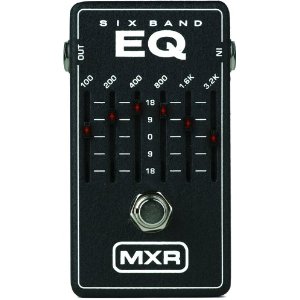 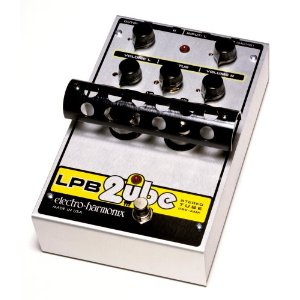 |
Since the Magnum only consists of a volume knob & a brightness switch. The next two pedals needed to be thrown into the mix to sweeten things up. First, EQ is being done by a 6 channel MXR EQ - I think I prefer knobs, but this pedal does the job. It also offers more control since you can bring down specific ranges of your tone. It definitely comes in handy. The Electro Harmonix LPB2ube is a tube preamp that sweetens & strengthens the tone by adding some tube drive & having two channels, I attached an AB switch so I can use one channel clean & one channel as a tube overdrive. The only annoying bit about this pedal is having to use the power supply that it comes with instead of powering if off of a brick supply. It has a lo & hi input knob, which comes in handy when I switch off between the Metropolitan & the Fender. The Metro comes in hot so switching the knob to Hi input dials it back without having to adjust the volume/drive settings. |
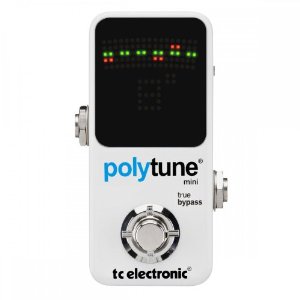 |
That completes the basic sound of my “amp” or rig or whatever you want to call it but how can you have a setup without a tuner? I’ve recently come to favor TC Electronics as a good mid/low-priced pedal. It started with the Polytune mini. Very small, very accurate & I can check the tuning of all 6 strings at once. & did I mention very small? My smart phone is larger than this tuner, let us not forget that it’s also “true bypass”. This starts my effects loop & I run it into a Crybaby Wah, which I may replace with something nicer or at least less beat up. I have a fuzz pedal for the big wall of sound power bits of our songs & I used to use an EH Big Muff Pi; but, as the name suggests, it was big & took up a lot of real estate on the pedal board. In the past, I had replaced my EH Holy Grail (reverb) pedal with the Holy Grail Nano & while it was a decent pedal, it just didn’t perform to my liking & I didn’t want to go through that disappointment with the Nano version of the Muff. So I went with a clone version of a Big Muff. Fit into a typical square pedal casing about the size of an MXR. It nicely fits the layout of my pedal board & is practically as powerful as the EH Big Muff Pi. I’ll admit it doesn’t have quite the low grumble of the EH pedal, but it’s close & the benefit of the small chassis is definitely worth the slight loss of low end. |
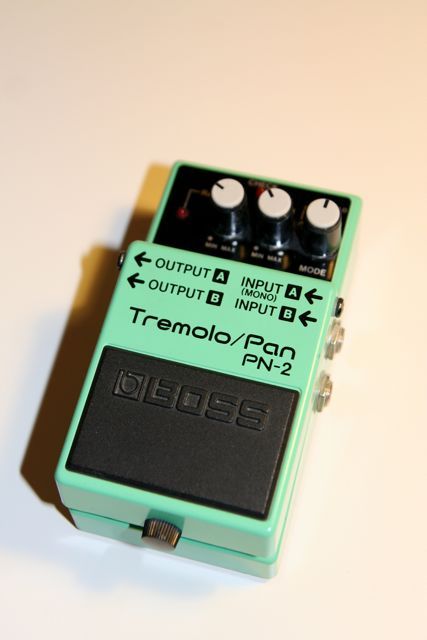 |
My last remaining BOSS pedal, is the Tremolo/Pan PN-2. It may no longer be in production. It’s at times a very important part of my setup (see Plumerai songs “Six Ton Gorilla”/“Empty Graves”/“Intangible” for example). However, since upgrading a few of my other BOSS pedals, I can now really hear the tone suck when I click it on, especially in the low ranges. Which means the clock is ticking on when the PN-2 gets replaced. |
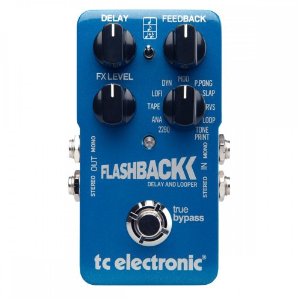 |
Part of the reason I’m practically BOSS free these days is my discovery of TC Electronic. I used to not be able to part with my Boss Delays until I found this nice decently priced replacement. While I would love an analog delay, they’re just not versatile enough for me, especially with my occasional foray into more experimental/looped/droney territory like on the Goddakk records. But this pedal the Flashback has everything I need in the delay as well as a looping function. So it’s like I lost one pedal, but gained two. It has a multitude of settings, analog, tape, reverse etc…. So there’s more of a variety of sounds than the Boss & it doesn’t suck your tone like the Boss does. The Flashback also makes use of Toneprint, which is a setting on the pedal where I can download from the interwebs or straight from my smartphone a delay sound designed by some celebrity guitarist. Unfortunately the pedal is geared toward the Guitar Center crowd so most of the tone prints & advertising sort of turns me off as I’m not a fan of Dream Theater or Santana, but it’s a nice feature because if I get bored with the pedal I can download a new setting to tinker with. This pedal is a great versatile delay to have & when you’re lugging around all your gear, it’s nice to not have to carry around multiple pedals to do similar jobs or to have to switch out pedals depending on the gig or the song. There’s also a switch to choose one of three types of delay repeats, half note, quarter note, & a combination so you have a bit more options as to the rhythmic pattern of your delay. |
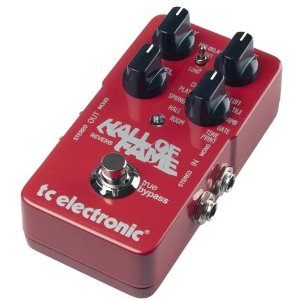 |
Similarly, I also switched out the aforementioned EH Holy Grail Nano with a TC Electronic Hall of Fame Reverb Pedal. I started with the Holy Grail when my JC-120’s reverb stopped working. It was a nice time while it lasted, but eventually the pedal started squealing at random intervals. So out with the Holy Grail in with the Holy Grail Nano. I read that it was very close in sound to its bigger counterpart. While that may be true, I felt that there was a range of effect missing from the Nano. So my sound was either too dry or too wet & that sweet spot could never be found. So, I moved on to another TC Electronic pedal. Like the Flashback, there’s a multitude of Reverb types on the Hall of Fame & it’s also equipped with TonePrint & is true bypass. Sometimes it’s like having a rack multi-unit, but without the horrible sound quality of Line 6 & all with the compact & ease of use as a Boss or EH. |
All of this fits neatly onto one Pedal Train 2 board with a power brick secured underneath. So as a traveling man, you have your guitars on your back, pedals in one hand & cab in the other. The recent west coast tour saw the cab being checked-in & the pedals in the overhead bin. In a van, the setup leaves room for your bassist to bring their 6 foot Ampeg cab that is going to be bigger than the stage you’re playing on & if you’re playing places that are backlined, you’ll have your sound that you can power their cab with instead of dealing with a beat up Marshall stack from 1984 with missing knobs & a channel button stuck or not working. While I don’t pretend that this sound surpasses or is even equivalent to buying a Fender Twin Reverb or Vox or what have you, chances are for a live/touring scenario, you’ll be happier you didn’t lug a big heavy amp down the stairs into a basement club & back again. As an added bonus each component is approximately $150 give or take, so if it craps the bed you can just replace the one component without having to shell out $600+ to acquire the same or similar model amp at the last minute to continue a tour.
Only hours off the plane, here’s this rig in action (minus the TC Electronic components at the time I was using the BOSS DD5 & EH Holy Grail Nano). Take into consideration this is recorded through horrible camcorder mic.
Guitarist interview with Martin Newman of Plumerai & Goddakk (June 2010)
Plumerai interview (January 2008)
Plumerai interview (December 2005)
burMonter interview (April 1995)
